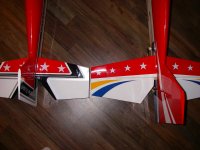Those 2 are the latest generation slicks and have much narrower fuselages. My 89 slick fuse is pretty close to the 104 fuse.
I believe the 51 and 89 are one generation and the 42 and 71 are the next one, but I am by no means a 3DHS historian. Not sure where the 126 fits in there.
The 71 slick on electric is pretty nice. I preffered it to gas version I have now.
Sometimes I like to compare apples with oranges.

The plane on the left is a 48" Extra EXP. I don't need to fly an EF 60" EXP to know that the pitch authority is probably going to, for lack of a better term, "out-perform" my 59" slick. Having said that, you can also see the fuse width of the slick is also sized similarly. The Slick's wing tube sleeve is 5 1/2" long whereas the Extras is 5" long. I had no way of expecting how skinny this thing would appear to be.
I'm out of my league discussing aircraft design with most of the you, but my presumption is that the 59" AJS doesn't
lack anything, it simiply has a differently proportioned design. The side area of the fuse is massive, and I have heard Andrew Jesky speaking about the side area requirement of F3A planes. My interpretation is that he needs a pattern plane to perform as similarly, both in knife edge as well as in a wings-level condition as possible; needing relatively little rudder/throttle compensation. Again, simply making presumptive statements, I am inclined to believe this is the basic design brief with the 59", or latest generation Slicks. Before reading these posts, I had no idea that there were generations of 3DH Slick designs. Thanks.
I will now finish speaking as though you needed my advice...
The winds have been up around 10-12mph and almost dead across the runway for the past couple weeks. The 59 simply handles these conditions with absolute aplomb. I know a decent amount of my favorable impressions of this plane are simply due to its size and tremendous power, ie I will not make any statement, express or implied that I think any other 60" plane won't perform as well. I will say that I believe it has a very balanced and extremely direct control authority that motivates you to fly in a more polished- even scale fashion?? While landing, it becomes immediately evident that it will maintain a glide slope at virtually any speed, meaning it's very predictable with a gusting cross wind and simply will not fight you when you ask it to hold a line. I feel like it both gains (pure 3D plane territory) but also sheds lift almost equally. That is what flying a precision/IMAC oriented 3D plane means to me.
FWIW I fly the little Extra in any wind I fly the 59 in and it's a complete nut. More of an adrenaline kick for sure.

